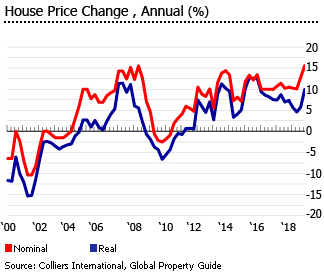The Philippines is now in its 8th year of a house price boom
The Philippines’ residential property market continues to perform very well, due to robust economic growth. Makati CBD property prices have risen by almost 132% from 2010 to 2018. Yet prices are not high, and yields are good, and the Philippine economy is in the 8th year of strong growth.
The average price of a luxury 3-bedroom condominium unit in Makati central business district (CBD) soared 15.55% (9.91% inflation-adjusted) during 2018 to PHP230,000 (US$4,371) per square metre (sq. m.), from y-o-y rises of 10.46% in 2017, 9.95% in 2016, 13.43% in 2015, 7.11% in 2014, 14.37% in 2013, and 10.06% in 2012, according to Colliers International. During the latest quarter, condominium prices in Makati CBD increased 5.02% (5.55% inflation-adjusted) in Q4 2018.
House prices continue to rise in other major Metro Manila CBDs:
- In Rockwell Center, the average price for a 3-bedroom condominium rose by 10.6% (5.2% inflation-adjusted) to PHP244,500 (US$4,650) during 2018
- In Fort Bonifacio, the average price for a 3-bedroom condominium soared by 17% (11.3% inflation-adjusted) to PHP205,500 (US$3,908) per sq. m over the same period.
However, house price growth is more muted nationwide. During the year to Q3 2018, the nationwide residential real estate price index rose by 4.4% (-2.2% inflation-adjusted), according to the Bangko Sentral ng Pilipinas (BSP), the country’s central bank. Quarter-on-quarter, the index dropped 0.6% (-2.8% inflation-adjusted) in Q3 2018. The residential real estate price index, published every quarter, is based on bank reports on residential real estate loans.
By property type:
- Condominium units saw y-o-y price increase of 5.8% (-0.8% inflation-adjusted) in Q3 2018 from a year earlier
- For single detached/attached house, prices rose by a meager 0.2% (-6.1% inflation-adjusted) during the year to Q3 2018
- Duplex house prices surged 30.7% (22.5% inflation-adjusted) y-o-y in Q3 2018
- Townhouse prices rose by 18.3% (10.9% inflation-adjusted) over the same period
In the National Capital Region (NCR), residential property prices increased 6.8% (0.1% inflation-adjusted) during the year to Q3 2018 while in Areas Outside the NCR (AONCR), prices rose by 2.2% (-4.2% inflation-adjusted), according to the BSP.
Demand remains strong. In 2018, the take-up of pre-sold condominium uits throughout Metro Manila, including fringe locations, reached 54,000 units – surpassing the previous record-high of 52,600 units in 2017, according to Colliers International. This was mainly due to strong demand from starting families and young professionals and the influx of Mainland Chinese in the Philippines. Household formation has increased by an average of 3% every year in the past five years.
Residential property demand is expected to remain robust this year:
- “Colliers believes that pre-sales in 2019 will likely remain strong given the strong end-user demand. However, topping the 2018 sales figures might be a challenge given Colliers’ projected slowdown in launches due to the dearth of available developable land in Metro Manila and the continued acceleration of land prices in the country’s key business districts.”
- “Local and foreign high net worth individuals continue to drive the residential sale market, typically securing the biggest and most expensive units from high-end and luxury brands to maximize the value appreciation in major markets,” said Jones Lang LaSalle in its 2018 report.
In 2018, the Philippine economy expanded by about 6.2%, according to the Philippine Statistics Authority (PSA). It was lower than the average annual growth rate of 6.6% from 2012 to 2017 but still places the country as among the fastest growing economies in Emerging Asia. The economy is expected to grow at a faster pace of 6.7% this year, amidst improving macroeconomic conditions and slowing inflation, according to ADB President Takehiko Nakao.
Land values continue to appreciate
Land prices continue to rise in all major high-end residential areas, according to Leechiu Property Consultants:
- In Forbes Park, land prices surged almost 34% y-o-y to an average of PHP375,000 (US$7,123) per sq. m. in 2018.
- In Ayala Alabang, land prices increased 15.8% to an average of PHP110,000 (US$2,089) per sq. m. in 2018 from a year earlier.
- In Dasmariñas Village, the average land value increased 8.4% to PHP374,000 (US$7,104) per sq. m. in Q1 2018 from the prior year.
- In Urdaneta Village, land values rose by 8% to an average of PHP270,000 (US$5,129) per sq. m. in Q1 2018 from a year earlier.

Land prices are projected to continue rising in the medium term.
LAND PRICES IN SELECTED HIGH-END RESIDENTIAL VILLAGES, 2010-Q1 2018 | |||
| PHP per sq. m. | USD per sq. m. | Growth from 2010 to Q1 2018 | |
| Dasmariñas Village | 374,000 | 7,104 | 316% |
| Forbes Park | 300,000 | 5,698 | 275% |
| Urdaneta Village | 270,000 | 5,129 | 286% |
| Corinthian | 252,000 | 4,787 | 288% |
| Greenhills East | 210,000 | 3,989 | 265% |
| Greenmeadows | 160,000 | 3,039 | 286% |
| Valle Verde | 150,000 | 2,849 | 216% |
| Ayala Alabang | 95,000 | 1,804 | 222% |
| Hillsborough | 58,000 | 1,102 | 314% |
| Source: Leechiu Property Consultants | |||
Philippine residential property is still below pre-Asian Crisis values!
Surprisingly, despite so much price appreciation, the Philippine housing market has still not recovered from the crash after the 1997 Asian Financial Crisis. Between 1997 and 2004, luxury condominium prices dropped 28% (52% inflation-adjusted), in the biggest property crash of all countries affected by the Asian Financial Crisis.
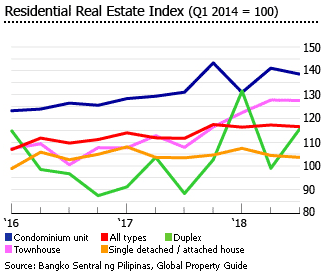
In current price terms, both rental rates and property values are already far above 1997 levels. However residential property prices in 2018 are still 9% below pre-Asian Financial Crisis levels in real, inflation-adjusted terms.
Residential construction activity rising
After a weak activity in 2017, residential construction has improved in 2018, based on figures from the Philippine Statistics Authority (PSA).
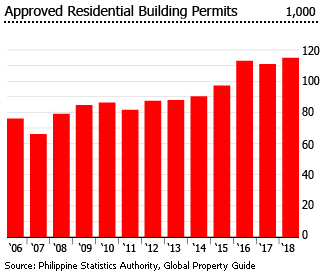
During 2018:
- The number of approved residential building permits rose by 3.6% y-o-y to 114,905 units
- The floor area of residential building permits surged 27.5% y-o-y to 20,783,947 sq. m.
- Total value of residential building permits increased 38.5% y-o-y to PHP227.42 billion (US$4.33 billion).
During the year to Q4 2018, residential constructions increased for all types: residential condominiums (106.5%); duplex/quadruplex (78.3%), apartments (27.2%) and single-type houses (25.2%).
Housing supply continues to rise
The total condominium stock in Metro Manila’s CBDs reached 118,870 units in 2018, up by about 11% from 107,100 units in 2017, according to Colliers. In 2018 alone, about 11,800 units were completed, down from 15,900 units completed in 2017 but still up from an annual average of 7,500 units in the past ten years.
Fort Bonifacio and the Manila Bay Area accounted for the biggest share of condominium units delivered in Q4 2018 of 75%, buoyed by the strong demand from offshore gaming employees, as well as local and foreign investors. The major residential projects completed in Fort Bonifacio were Avida Towers Verte, Central Park West, and Grand Hyatt Residences by Federal Land. In the Manila Bay Area, Shore Residences Building 3 were already completed in Q4 2018, which added about 2,000 units to the total condominium stock. In other business hubs such as Makati CBD, Rockwell Center and Ortigas Center, completed residential projects included The Lerato Tower 3, Twin Oaks Place East Tower, and The Proscenium at Rockwell’s Kirov and Sakura towers.
In 2019, about 9,300 units are expected to be completed, with about three-fourths of new supply coming from Fort Bonifacio and the Manila Bay Area, according to Colliers.
RESIDENTIAL SUPPLY | |
| Location | Total Stock |
| Alabang | 4,230 |
| Araneta Center | 4,550 |
| Eastwood City | 8,540 |
| Fort Bonifacio | 32,230 |
| Makati CBD | 27,020 |
| Manila Bay Area | 19,850 |
| Ortigas Center | 17,940 |
| Rockwell Center | 4,510 |
| TOTAL | 118,870 |
| Source: Colliers International | |
Residential rents rising; vacancy rates falling
Residential rents across CBDs are now rising, amidst strong local and foreign demand and falling vacancy rates.
During 2018:
- In Makati CBD, monthly residential rents rose by 2.6% y-o-y to an average of PHP824 (US$15.7) per sq. m.
- In Fort Bonifacio, monthly residential rents soared by 40% y-o-y to PHP1,134 (US$21.6) per sq. m.
- In Rockwell, monthly residential rents rose by 2.3% y-o-y to an average of PHP893 (US$17) per sq. m.
Rents are expected to remain almost steady this year, amidst a modest increase in supply.
“We see rents in Makati CBD, Fort Bonifacio, and Rockwell Center rising by 0.8% in 2019 despite the delivery of a modest number of new units over the next 12 months,” said Colliers.
RENTAL RATES FOR A 3-BR CONDOMINIUM UNIT, 2018 | ||||
| Monthly Rent | Y-O-Y change | Q-O-Q change | ||
| Location | PHP per sq. m | USD per sq. m | % | % |
| Fort Bonifacio | 624 – 1,020 | 12 – 19 | 40.0 | 0.7 |
| Makatic CBD | 550 – 1,098 | 10 – 21 | 2.6 | 0.6 |
| Rockwell Center | 744 – 1,042 | 14 – 20 | 2.3 | 0.7 |
| Sources: Colliers International, Global Property Guide | ||||
In Metro Manila, the overall vacancy rate stood at 10.6% in Q4 2018, down from 10.8% in the previous quarter and 12.6% a year earlier, according to Colliers International.
Vacancy rates in Metro Manila are expected to fall further to about 10.5% this year and to about 10.3% by 2021, partly due to developers’ slower completion of new units in the coming years.
“The stable take-up of units in the secondary market suggests that the market is driven by a strong end-user demand and not by mere speculative demand,” said Colliers.
Gross rental yields remain high, but beware of taxes
According to research by the Global Property Guide, gross rental yields in Metro Manila remain good, ranging from 7.01% on the very smallest condominium units of 45 sq. m. to 7.16% on 80 sq. m. condominiums.
These yields are before taxes and other expenses. They are for the high-end areas: Makati CBD, Ortigas CBD, Rockwell, The Fort, and Eastwood City.
This does not mean that foreign investors should necessarily rush to invest in Manila, because transaction taxes (known as ‘capital gains taxes’, but not actually such), and (if observed) official income tax rates applicable to non-resident investors, are high.
Interest rates rising; mortgage market remains small
Currently, housing loan rates charged by major commercial banks range from 4.99% to 7.5% for one-year fixed loans, and from 7.5% to 9.75% for ten-year fixed mortgages. In March 2019, the BSP has kept its policy rate at 4.75% for overnight borrowing, after raising it five times last year. The overnight lending and repurchase facility (RF) and deposit facility were also held steady, at 5.25% and 4.25%, respectively.
Severe problems impede mortgage market growth. Few major banks offer housing loans. And although loan-to-value ratios of 90% are now in theory being offered and loan tenors can be as long as 30 years, in fact most loans are short-term. Banks are wary because land titling and registration problems are prevalent, as are lengthy delays in the foreclosure process due to the country’s very weak court system. Therefore approval of loan applications takes a long time. In addition inter-bank collusion prevails: different banks’ loans have strangely similar terms and conditions.

Property buyers also face high transaction costs, corruption and red tape, fake land titles and substandard building practices. Plus, the large informal housing sector and their incentives make it less attractive for low to middle income families to buy or rent properties.
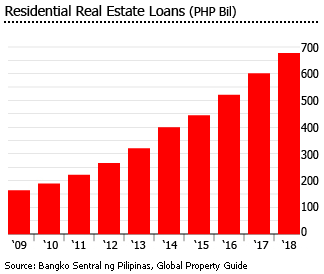
Because of these factors, the ratio of residential mortgage loans to GDP remains small, at around 3.85% of GDP in 2018, a slight increase from 2.03% of GDP in 2009. Most houses in the Philippines are sold for cash or pre-sold, with the developers offering financing.
In 2018, the total outstanding residential real estate loans rose by 12.8% to PHP677.1 billion (US$12.88 billion) from a year earlier, based on figures from the BSP.
Manila’s segmented market
Lower down the income scale there is cause to worry.
There are three identifiable segments in Manila’s housing market:
- The high end. Local high-earners and expatriates occupy this segment.
- The middle tier. The mid-end condominium sector, with monthly amortization of around PHP10,500 (US$200), presently requiring a dispensable income greater than PHP34,962 (US$665), to obtain a housing loan of PHP2 million (US$38,037). This segment has been targeted by many developers, and is attractive to overseas foreign workers (OFWs).
- The low end. This is where the mass of the population live.
We believe that the middle tier is over-supplied. Many of these lower middle-class condominium developments are ghost cities.
Manila’s ghost cities
A visit to any ‘Barrio Fiesta’ in any city where Philippine OFWs work abroad is dominated by condominium offerings from developers like Megaworld, DMCI, Ayala Land, etc. The Philippines is one of the world’s largest remittance recipients, with 10.5 million Philippine Overseas Foreign Workers (OFWs) living and working in 210 countries and territories worldwide, 47% of them permanent migrants, 40% temporary, and the rest “irregular migrants”. Among the permanent overseas Filipinos, 65.2% live in the US, followed by Canada (13.1%), Europe (7.1%), Australia (6.8%), and Japan (3.4%), according to the Commission on Filipinos Overseas (CFO). In 2018, total cash remittances reached a record high of US$28.94 billion (or about 8.7% of GDP), up by 3.15% from a year earlier.
It is estimated that 60% of these remittances go directly or indirectly to the real estate sector, according to the World Bank. These OFW remittances power the low-end to mid-range residential property market, housing projects and mid-scale subdivisions in regions near Metro Manila, such as Cavite, Batangas, and Laguna Provinces.
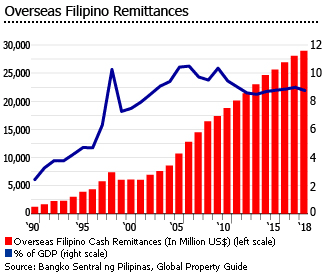
According to the Philippine Housing and Land Use Regulatory Board, 452,198 condominium units were built in Metro Manila from January 2001 to March 2014. The condominium stock increased further in recent years, with an additional 67,699 units covered by licenses to sell in 2015, 99,524 units in 2016 and 104,196 units in 2017. In 2018, about 35,700 units were completed in Metro Manila, mainly coming from Quezon City and Pasay City, according to Jones Lang LaSalle.
There are around 807,496 families or 27.5% of the NCR population who have a dispensable income greater than PHP34,962 (US$672), which is the required monthly income to be able to afford the monthly amortization of PHP10,500 (US$202). PHP10,500 (US$200) is the minimum monthly amortization for a housing loan of PHP2 million (US$38,037), with accommodating loan rates of 90% LTV, with an annual interest rate of 5.7%, and a loan tenor of 30 years.
So for all these newly-built condominiums to be occupied by those who could afford to rent or buy (we calculate for the buying case, but given current interest rates it may be more expensive to rent), the majority of locals who have the financial capacity to occupy them would need to purchase or rent a unit, for the available supply of condominium units to be taken up.
These are problematic numbers given that many of these families already have houses in the first place. The World Bank assumes only 10% of these capable end-users as prospective end-users, indicating a gross oversupply.
In terms of affordability, property developers are building more mid-end condominium units than locally-based Filipinos can afford to occupy. Many of the buyers are OFWs, causing a mismatch between demand and supply.
The average annual growth of remittances from 2009 to 2018 was only 5.8% , compared to 15.5% annually from 2002 to 2009. The World Bank believes the slowdown in remittances is due to:
- Stricter implementation of the migrant workers’ bill of rights;
- Political uncertainties in host countries; and
- The slowdown in the advanced economies.
“Affordable” housing shortage
The Philippines has a huge housing need at the low end. Nationwide, the country has a housing shortage of about 4 million units, according to the Subdivision and Housing Developers Association (SHDA). Most of this would need to be socialized housing – units with a selling price of under PHP450,000 (US$8,548). In Metro Manila, as many as 300,000 households reside in informal and semi-uninhabitable housing units, composing 8.7% of Metro Manila’s total population. These people live in appalling conditions. Many others live in very poor conditions.
To meet the needs of these families, the government embarked on the National Shelter Program to provide housing for informal settlers and other families who do not have enough income to rent nor buy houses in the prevailing markets rates.
Socialized housing units, or those which cost less than PHP450,000 (US$8,548) can be purchased with a monthly amortization of PHP2,302 (US$44). The Pag-Ibig Fund, (which is the Filipino word for love), the country’s state-owned and subsidized housing loan provider, provides a fixed rate of 4.5% for 30 years for socialized housing units.
The problem is that these low-end housing units are usually far from work.
Philippine peso remains weak, amidst a record trade deficit
The Philippine peso lost about 11% of its value against the U.S. dollar in the past three years, from an exchange rate of PHP47.191 = US$1 in December 2015 to PHP52.871 = US$1 in December 2018. In fact, it was its weakest performance in over 13 years, amidst a record trade deficit caused by a surge in imports.

In 2018, the country posted a record high trade deficit of US$41.44 billion, up from US$27.38 billion in 2017 and US$26.7 billion in 2016, as imports surged and exports dropped last year, according to the PSA.
The wider trade deficit resulted in a ballooning current account deficit as more dollars were being spent for importation – putting more pressure on the Philippine peso. In 2018, the country’s current account deficit was estimated at US$6.4 billion – over twice larger than the previous projection of US$3.1 billion. The current account deficit is expected to increase further to US$8.4 billion in 2019.
Recently, Socioeconomic Planning Secretary Ernesto Pernia expressed concern over the country’s widening current account shortfall.
“A widening current account balance due to rising capital goods imports and anemic exports growth is a cause for concern,” said Pernia. “The widening gap emphasizes the need to reform legislation to allow foreign investments in firms catering to the domestic market, in addition to expanding their exporting activities.”
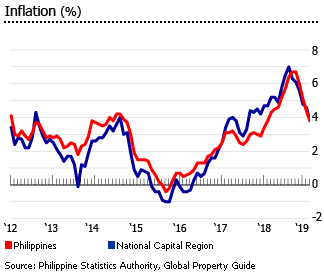
In February 2019, the country’s inflation rate was 3.8%, down from 4.4% in January 2019 and 5.1% in December 2018 and within the government’s target range of 2% to 4%, mainly due to slower price increases of food and non-alcoholic beverages. Nationwide inflation stood at 5.2% in 2018 – the highest in a decade – as a result of oil price hikes and the impact of the Tax Reform for Acceleration and Inclusion (TRAIN) law signed last December 19, 2017.
Uninterrupted economic growth
In 2018, the Philippine economy expanded by about 6.2%, according to the Philippine Statistics Authority (PSA). It was lower than the average annual growth rate of 6.6% from 2012 to 2017 but still places the country as among the fastest growing economies in Emerging Asia. During Q4 2018, industry had the fastest growth, with 6.9%, followed by services (6.3%) and agriculture (1.7%).
The total number of foreign tourist arrivals rose by 7.7% to 7.1 million people in 2018 from a year earlier, according to the Department of Trade and Industry (DTI). South Korea remained the country’s top tourism market with 22.3% share, followed by China (17.6%), the US (14.5%), Japan (8.9%) and Australia (3.9%).
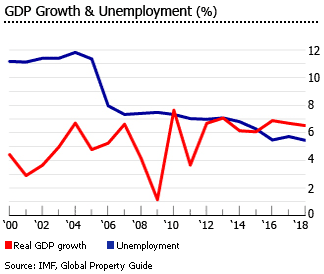
The economy is expected to grow at a faster pace of 6.7% this year, amidst improving macroeconomic conditions and slowing inflation, according to ADB President Takehiko Nakao.
In 2018, the nationwide unemployment rate stood at 5.3%, down from 5.7% in 2017, 5.5% in 2016, 6.3% in 2015, 6.6% in 2014 and 7.1% in 2013, according to the PSA. Unemployment is expected at 5.5% this year, from an annual average of 6.6% from 2008 to 2018, according to the IMF.
The Philippine economy grew by an average of 6.3% annually from 2010 to 2016, thanks to the previous administration’s socioeconomic reforms. Former president Benigno (Noynoy) Aquino III (president June 2010 – June 2016) instituted a no-holds barred anti-corruption campaign which wowed foreign investors and caused consumer confidence to surge. The Philippines’ investment ratings were upgraded to investment grade by Moody, Standard & Poors’, and Fitch Ratings. The Philippines’ competitiveness improved sharply, with a Global Competitiveness Index rank of 47th out of 140 economies in 2015-16, up from 52 in 2014, 59 in 2013, and 65 in 2012.
However, the country’s competitiveness rank slipped back to 57th in 2016-17 and to 56th in both the 2017-18 and 2018-19 ranking.
During the May 2016 presidential election, former Davao City mayor Rodrigo Duterte won a landslide victory, capitalizing on discontent with rising inequality and on the perceived incompetence of Aquino’s chosen successor, Mar Roxas. Duterte vowed to bring progress to all Filipinos, to eliminate government corruption and to substantially reduce crimes, especially the use of illegal drugs. While the government’s “war on drugs” is now very controversial having resulted in the death of over 7,000 Filipinos, Duterte’s net trust rating remains either “excellent” or “very good”, based on the Social Weather Stations (SWS) surveys.
Duterte’s push for a charter change to shift to a federal system of government from the current unitary system was also very controversial.
Duterte’s “Build, Build, Build” infrastructure program
President Duterte’s ambitious US$180-billion “Build, Build, Build” program is designed to modernize the country’s infrastructure by rolling out 75 flagship projects, including 6 airports, 9 railways, 3 bus rapid transits, 32 roads and bridges, 4 seaports, 4 energy facilities, 10 water resource projects and irrigation systems, and 5 flood control facilities, among others.
Nine of these projects are currently under construction, including the Clark Airport expansion; the first phase of the Metro Manila subway; the North-South railway projects; the 130-km first phase of the Mindanao railway; the Kaliwa water supply project; and the Cavite flood control project, among others.
Some 28 projects are projected to be completed before the end of Duterte’s term in 2022. These projects are expected to sustain strong economic growth, raising annual infrastructure spending by about 3% to 7% of GDP until 2022.
“We will make the next few years the golden age of infrastructure in the Philippines to enhance our mobility and connectivity, and thereby spur development growth,” said Duterte. “In other words, we are going to build, build and build.”
Unsurprisingly, the Philippine government breached its budget deficit cap last year, as expenditures exceeded target and outpaced the increase in revenues. In 2018, fiscal deficit reached PHP558.3 billion (US$10.6 billion), up 59% from the PHP350.6 billion (US$6.66 billion) gap recorded in 2017, according to the Bureau of the Treasury. As percent of GDP, the deficit was equivalent to 3.2% of GDP in 2018 – overshooting the 3% target for the year.
Revenue generation increased 15% y-o-y to PHP2.85 trillion (US$54.13 billion) in 2018, thanks to the implementation of the Tax Reform for Acceleration and Inclusion (TRAIN) law, which was projected to add PHP63.3 billion (US$1.2 billion) to state coffers in its first year. On the other hand, government spending surged 21% y-o-y to PHP3.4 trillion (US$64.58 billion) in 2018, amidst heightened social protection and infrastructure spending, particularly massive projects under its “Build, Build, Build” program.
For 2019, the government has set a wider deficit ceiling at PHP624.2 billion (US$11.86 billion).
Sources:
- Residential Real Estate Price Index (Bangko Sentral ng Pilipinas): http://www.bsp.gov.ph/statistics/keystat/rrepi.htm
- World Economic Outlook Databases (International Monetary Fund): https://www.imf.org/en/Publications/SPROLLS/world-economic-outlook-databases#sort=%40imfdate%20descending
- Philippines: Selected Domestic Interest Rates (Bangko Sentral ng Pilipinas): http://www.bsp.gov.ph/statistics/spei_pub/Table%2019.pdf
- Overseas Filipinos’ Cash Remittances (Bangko Sentral ng Pilipinas): http://www.bsp.gov.ph/statistics/keystat/ofw2.htm
- Colliers Quarterly: New Record High (Colliers International): https://www.colliers.com/-/media/files/colliers%20quarterly%20manila%20q4%202018%20residential.pdf?la=en-gb
- Construction Statistics from Approved Building Permits: Fourth Quarter 2018 (Preliminary Results) (Philippine Statistics Authority): https://psa.gov.ph/content/construction-statistics-approved-building-permits-fourth-quarter-2018-preliminary-results
- Philippines: rental yields in Manila range from good to excellent (Global Property Guide): https://www.globalpropertyguide.com/Asia/Philippines/Rental-Yields
- Interest rates unchanged as inflation slows (Philstar): https://www.philstar.com/business/2019/03/22/1903446/interest-rates-unchanged-inflation-slows
- Monetary Policy Decisions (Bangko Sentral ng Pilipinas): http://www.bsp.gov.ph/monetary/monetary.asp
- Metro Manila Property Market Overview 2018 (Jones Lang LaSalle): http://www.jll.com.ph/philippines/en-gb/Research/JLL-Metro-Manila-Property-Market-Overview-4Q18.pdf
- Philippine GDP grows 6.1 percent in the fourth quarter of 2018; 6.2 percent in 2018 (Philippine Statistics Authority): https://psa.gov.ph/nap-press-release
- Philippines posts wider-than-expected budget deficit in 2018 amid spending boost (Philstar): https://www.philstar.com/business/2019/02/22/1895873/philippines-posts-wider-expected-budget-deficit-2018-amid-spending-boost
- Tourist Arrivals (Department of Trade and Industry): https://www.dti.gov.ph/resources/statistics/tourist-arrivals
- Jobless rate eased to 5.3% in 2018; underemployment up at 16.4% (Inquirer.net): https://business.inquirer.net/262926/jobless-rate-eased-to-5-3-in-2018-underemployment-up-at-16-4?utm_expid=.XqNwTug2W6nwDVUSgFJXed.1
- Palace: Duterte’s ‘very good’ rating shows ‘unshakeable trust’ (Inquirer.net): https://newsinfo.inquirer.net/1094633/palace-dutertes-very-good-rating-shows-unshakeable-trust?utm_expid=.XqNwTug2W6nwDVUSgFJXed.1
- 28 ‘Build, Build, Build’ projects finished by 2022: official (ABS CBN News): https://news.abs-cbn.com/business/03/05/19/28-build-build-build-projects-finished-by-2022-official
- PH posted record trade deficit of $41.44 billion in 2018 (Inquirer.net): https://business.inquirer.net/264922/ph-posted-record-trade-deficit-of-41-44-billion-in-2018
- Finally! Inflation in February 2019 falls within target at 3.8% (Rappler): https://www.rappler.com/business/224946-inflation-rate-philippines-february-2019


